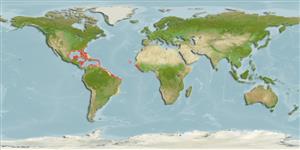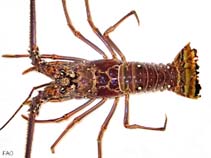Panulirus argus (Latreille, 1804)
Caribbean spiny lobster| Native range | All suitable habitat | Point map | Year 2050 |

|
| This map was computer-generated and has not yet been reviewed. |
| Panulirus argus AquaMaps Data sources: GBIF OBIS |
Classification / Names Common names | Synonyms | CoL | ITIS | WoRMS
Malacostraca | Decapoda | Palinuridae
Environment: milieu / climate zone / depth range / distribution range Ecology
Benthic; depth range 0 - 90 m (Ref. 441). Tropical, preferred 27°C (Ref. 107945); 35°N - 24°S, 97°W - 11°E (Ref. 4)
Distribution Countries | FAO areas | Ecosystems | Occurrences | Introductions
Atlantic Ocean.
Length at first maturity / Size / Weight / Age
Maturity: Lm 8.3, range 7 - 8.1 cm Max length : 45.0 cm TL male/unsexed; (Ref. 4); common length : 20.0 cm TL male/unsexed; (Ref. 4); max. reported age: 15 years (Ref. 129472)
Longevity from Ref. 129472 (Supplementary material). Occurs at depths down to 90 m, perhaps even deeper; usually inhabits shallow waters and found among rocks, on reefs, eelgrass beds or in any habitat that provides protection. The species is gregarious and migratory. Females move to deeper water for spawning and there are mass migrations in the autumn when the animals, in single files up to 50 individuals, move in a certain direction in daytime, each animal having body contact with the next through the antennae; In the northern part of its range, larvae are found mainly from June to December (Ref. 4).
Life cycle and mating behavior Maturity | Reproduction | Spawning | Eggs | Fecundity | Larvae
Females move to deeper water for spawning and there are mass migrations in the autumn when the animals, in single files up to 50 individuals, move in a certain direction in daytime, each animal having body contact with the next through the antennae; In the northern part of its range, larvae are found mainly from June to December (Ref. 4).
Main reference
References | Coordinator | Collaborators
Holthuis, L.B. 1991. (Ref. 4)
IUCN Red List Status (Ref. 130435)
Data deficient (DD) ; Date assessed: 03 December 2009
CITES status (Ref. 108899)
Not Evaluated
CMS (Ref. 116361)
Not Evaluated
Threat to humans
Human uses
Fisheries: commercial
FAO - Fisheries: landings, species profile | FIRMS (Stock assessments) | FishSource | Sea Around Us
Tools
More information
Internet sources
BHL | BOLD Systems | CISTI | DiscoverLife | FAO(Fisheries: species profile; publication : search) | Fishipedia | GenBank (genome, nucleotide) | GloBI | Gomexsi | Google Books | Google Scholar | Google | PubMed | Tree of Life | Wikipedia (Go, Search) | Zoological Record
Estimates based on models
Preferred temperature
(Ref. 115969): 23.7 - 28, mean 26.7 (based on 346 cells).
Resilience
(Ref. 69278):
Medium, minimum population doubling time 1.4 - 4.4 years (K=0.16-0.39; tm=4).
Prior r = 0.82, 95% CL = 0.54 - 1.23, Based on 1 full stock assessment.
Nutrients: Calcium = 109 [35, 184] mg/100g; Iron = 1.59 [1.21, 1.97] mg/100g; Protein = 20.2 [19.2, 21.3] %; Omega3 = 0.285 [0.185, 0.386] g/100g; Selenium = 48.3 [-31.7, 128.3] μg/100g; VitaminA = 0 μg/100g; Zinc = 1.79 [1.17, 2.40] mg/100g (wet weight).



